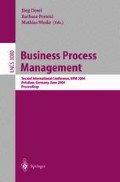Abstract
While collaboration has become a basic requirement for many development environments, solutions for collaborative modeling are far from being satisfact1ory. OPCATeam, which relies on Object-Process Methodology (OPM), provides a collaborative modeling environment that can fit generic modeling purposes. OPM, a holistic, bi-modal visual and textual approach to the study and development of systems, integrates the object-oriented and process-oriented paradigms into a single frame of reference. This characteristic, combined with refinement and abstraction mechanisms, makes OPM ideal for business process modeling. OPCATeam features multi-user Client-Server architecture. The server holds a single OPM model for each system in a central repository. OPCATeam has three access permission levels: workgroup, OPM model, and diagram. The diagram permission, which is unique to OPM, aims to reduce the number of conflicts between concurrent updates and preventing modelers from affecting shared elements while allowing them to refine these elements. Users can simultaneously update the model through the clients according to their access permissions. The detailed design implementation is currently being tested.
Access this chapter
Tax calculation will be finalised at checkout
Purchases are for personal use only
Preview
Unable to display preview. Download preview PDF.
References
Wang, L., Shen, W., Xie, H., Neelamkavil, J., Pardasani, A.: Collaborative conceptual design – state of the art and future trends. Computer Aided Design 34 (2002)
Dori, D.: Object-Process Methodology – A Holistic Systems Paradigm. Springer, Berlin (2002)
Potok, T.E.: Extensions to the spiral model to support joint development of complex software systems. In: Proceedings of the 30th Annual Southeast Regional Conference, ACM Press, New York (2002)
Usability First web site, http://www.usabilityfirst.com/groupware/intro.txl
IBM, Lotus Notes, http://www.lotus.com/products/product4.nsf/wdocs/noteshomepage
Microsoft, NetMeeting, http://www.microsoft.com/windows/netmeeting/
IBM, Lotus Sametime, http://www-1.ibm.com/servers/eserver/iseries/sametime/
SAP, http://www.sap.com/
Documentum, http://www.documentum.com
Kazanis, P., Ginige, A.: Asynchronous collaborative business process modeling through a web forum. In: Seventh Annual CollECTeR Conference on Electronic Commerce, Melbourne, VIC, Australia, in association with ACIS 2002 (2002)
Steinfield, C., Jang, C., Pfaff, B.: Supporting virtual team collaboration: the Team SCOPE system. In: Proceedings of the international ACM SIGGROUP conference on supporting group work, ACM Press, New York (1999)
Sure, Y., Erdmann, M., Angele, J., Staab, S., Studer, R., Wenke, D.: OntoEdit: Collaborative ontology engineering for the Semantic Web. In: Horrocks, I., Hendler, J. (eds.) ISWC 2002. LNCS, vol. 2342, pp. 221–235. Springer, Heidelberg (2002)
Gentleware, Poseidon for UML Enterprise Edition, http://www.gentleware.com
IBM. IBM Rational Rose, http://www.rational.com/products/rose/index.jsp
Canyon Blue Inc., Cittera UML collaborative tool, http://www.canyonblue.com/
Suzuki, J., Yamamoto, Y.: SoftDock: A Distributed Collaborative Platform for Modelbased Software Development
Yen, C., Li, W.J., Lin, J.C.: A web-based collaborative, computer-aided sequential control design tool. IEEE Control Systems Magazine, 272–1708 (2003)
Goldstein, H.: Collaboration Nation. IEEE Spectrum (June 2003)
Dori, D., Reinhartz-Berger, I., Sturm, A.: OPCAT – A Bimodal Case Tool for Object-Process based system development. In: 5th International Conference on Enterprise Information Systems (ICEIS 2003), pp. 286–291 (2003), Software download site: http://www.ObjectProcess.org/
Sun Microsystems, Inc. Java 2 Platform API Speciation, http://www.java.sun.com/products/jdk/.2/docs/api
Unified Modeling Language (UML), http://www.uml.org/
Soffer, P., Golany, B., Dori, D.,, M.: ERP Modeling: A Comprehensive Approach. Information Systems 28, 673–690 (2003)
Author information
Authors and Affiliations
Editor information
Editors and Affiliations
Rights and permissions
Copyright information
© 2004 Springer-Verlag Berlin Heidelberg
About this paper
Cite this paper
Dori, D., Beimel, D., Toch, E. (2004). OPCATeam – Collaborative Business Process Modeling with OPM. In: Desel, J., Pernici, B., Weske, M. (eds) Business Process Management. BPM 2004. Lecture Notes in Computer Science, vol 3080. Springer, Berlin, Heidelberg. https://doi.org/10.1007/978-3-540-25970-1_5
Download citation
DOI: https://doi.org/10.1007/978-3-540-25970-1_5
Publisher Name: Springer, Berlin, Heidelberg
Print ISBN: 978-3-540-22235-4
Online ISBN: 978-3-540-25970-1
eBook Packages: Springer Book Archive

